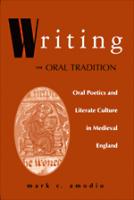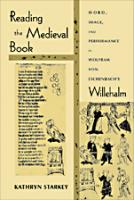Poetics of Orality and Literacy
- Mark C. Amodio, Writing the Oral Tradition: Oral Poetics and Literate Culture in Medieval England (2004)
 Mark Amodio's book focuses on the influence of the oral tradition on written vernacular verse produced in England from the fifth to the fifteenth century. His primary aim is to explore how a living tradition articulated only through the public, performance voices of pre-literate singers came to find expression through the pens of private, literate authors. Amodio argues that the expressive economy of oral poetics survives in written texts because, throughout the Middle Ages, literacy and orality were interdependent, not competing, cultural forces.
Mark Amodio's book focuses on the influence of the oral tradition on written vernacular verse produced in England from the fifth to the fifteenth century. His primary aim is to explore how a living tradition articulated only through the public, performance voices of pre-literate singers came to find expression through the pens of private, literate authors. Amodio argues that the expressive economy of oral poetics survives in written texts because, throughout the Middle Ages, literacy and orality were interdependent, not competing, cultural forces.After delving into the background of the medieval oral-literate matrix, Writing the Oral Tradition develops a model of non-performative oral poetics that is a central, perhaps defining, component of Old English vernacular verse. Following the Norman Conquest, oral poetics lost its central position and became one of many ways to articulate poetry. Contrary to many scholars, Amodio argues that oral poetics did not disappear but survived well into the post-Conquest period. It influenced the composition of Middle English verse texts produced from the twelfth to the fourteenth century because it offered poets an affectively powerful and economical way to articulate traditional meanings. Indeed, fragments of oral poetics are discoverable in contemporary prose, poetics, and film as they continue to faithfully emit their traditional meanings. [from the UNDP web page]
- Kathryn Starkey, Reading the Medieval Book: Word, Image, and Performance in Wolfram von Eschenbach's Willehalm (2004)
 Reading the Medieval Book examines one of the most important epic poems in thirteenth-century Germany and its redaction in a richly illustrated manuscript created just fifty-five years after the poem's composition. Starkey's book reveals that the Munich-Nuremberg manuscript (c.1270) of Wolfram von Eschenbach's Willehalm (c.1215) was compiled with both oral performance and the written medium in mind.
Reading the Medieval Book examines one of the most important epic poems in thirteenth-century Germany and its redaction in a richly illustrated manuscript created just fifty-five years after the poem's composition. Starkey's book reveals that the Munich-Nuremberg manuscript (c.1270) of Wolfram von Eschenbach's Willehalm (c.1215) was compiled with both oral performance and the written medium in mind.Wolfram contrasts the visual language of the court with the auditory one of the battlefield, drawing attention to the position of the narrator and the interpretive frame that he provides. The manuscript reflects Wolfram's clear interest in the oral and visual communication that played such a dominant role in court society of the thirteenth century. Starkey argues that rather than merely depicting the events of Willehalm's plot, the Munich-Nuremberg artists also visualized nuances and shifts in the text that may otherwise have become lost when the oral text was committed to the page. The Munich-Nuremberg redaction of Willehalm provides insight into the critical transition in the literary culture of lay people in the West from a primarily oral to a literate experience. [from the UNDP web page]


